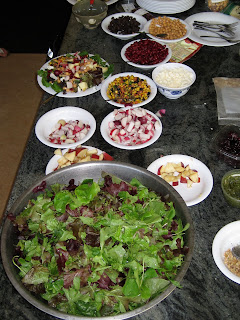Hi, everyone! I’m
sorry it’s taken me so long to post.
Things have been pretty busy around here. However, just because I didn’t post doesn’t mean there
wasn’t anything to blog about! The
last couple of months have been filled with exciting projects and even more
exciting produce.
For instance, at the end of June, the Garden held an
(E)scape party – a party for pickling scapes! At the same time, we made pesto from the vast quantities of arugula
we harvested and the garlic leftover from last year. I’ve posted both recipes below, in case you ever find
yourself overwhelmed by either of these vegetables.
 |
| Brent and Cedar with garlic from the garden |
 |
| The canning apparatus (to the right) |
I’ve never canned before, so I was thrilled to get the
opportunity to try my hand at it, under the knowledgeable guidance of Brent. The whole process is pretty extensive,
but it’s a wonderful way to make sure you’re eating your own vegetables all
year round! The procuedure breaks
down into several distinct steps: washing, chopping, preparing the brine,
blanching, filling, and sealing.
 |
| Washing the scapes |
The biggest concern with canning at home is preventing
growth of the bacterium Clostridium
botulinum from occurring after you’ve sealed your jars shut. C.
botulinum is a nasty little bug that . It colonizes the gut, leading to respiratory and musculoskeletal
paralysis. That's why it's so important to start with very, very clean mason jars (we washed ours thoroughly before using them).
 |
| Clean mason jars |
 |
| Blanching in brine |
Fortunately, the bug can be
destroyed by boiling for a few minutes and by keeping the pH of your brine
within a certain range. Blanching the scapes for a minute takes care of both of these steps,
cooking the bacteria and ensuring an even pH both inside and outside the
vegetable; thus, blanching is a key step in the canning process.
 |
| The scapes, in all their glory |
After blanching the scapes in our brine, we packed them as tightly as possible into mason jars. Then, we filled the remaining space in the jars with brine, knocking out all the air bubbles we could find.
Finally, we closed the jars by placing them in boiling water until a seal was created under the lids.
Voila – pickled scapes!
Garlic Scapes
Pickling brine and process
instructions
Brine ingredients:
4 cups apple
cider vinegar
3 cups water
1½ cups sugar
3 Tablespoons
kosher
salt
as
needed spices
Procedure:
1) Wash and cut garlic scapes
into jar-length segments, keeping the straight pieces and curved pieces
separate.
2) Pre-heat the jars and lids.
3) Mix brine ingredients and
bring to a boil. Add spices to brine, if desired.
4) Test the brine pH (should be ≤ 3.9).
5) Blanch the scapes in the
brine: boil one minute.
6) Remove the scapes and strain
the spices out of the brine, if used.
7) Pack the scapes into clean
warm jars. Curl the curved portions on the outer part of the jar, and put the
straight portions in the center of the jar.
8) Top off the jars within 1/2”
of the top with hot brine.
9) Seal the jars finger tight.
10) Process the jars in a boiling
water canner: quarts for 15 minutes, and pints for 10 minutes.
11) Allow the jars to cool before handling.
12) Test the equilibrium pH; it should be ≤ 3.9.
























































